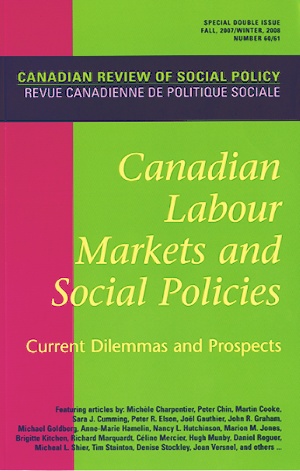Lutte contre la pauvreté et sécurité alimentaire au Québec: comparaison de la logique d'intervention gouvernementale et du discours des acteurs du terrain
Résumé
Duns le cadre d'une e'tude de cas sur la pertinence des interventions en se'curite' alimentaire, des acteurs oeuvrant auprks de la population de Que'bec touche'e par l'inse'curite' alimentaire ont expime' en entrevue des solutions pour ame'liorer la situation. L'objet de cet article est d'examiner si celles-ci cmespondent h la logique d'intervention sous-jacente h la strate'gie que'be'coise de lutte contre la pauvrete'. Alors que les parties penantes interviewe'es pre'conisent une approche globale pour s'attaquer aux de'terminants socio-e'conomiques de l'inse'curite' alimentaire notamment par des mesures sociaks pour re'soudre l'insuffisance de revenu, les dicideurs gouuernementaux s'en remettent essentielbment h l'insertion .en emploi, h l'aide alimentaire ponctuelle et aux projets communautaires ayant pour objectif de responsabiliser les individus et favoriser leur propre prise en charge. Au nom de l'incitation au travail, le gouvernement rnaintient les prestations d'aide sociale h un niveau trks faible, risqwznt de limiter l'accks aux aliments de nombreux me'nages. Les auteurs suggkrent de remettre en perspective la tension entre l'objectif d'assurer h chaque citoyen un revenu ¢ pour satisfaire les besoins essentiels et l'objectif de valoriser le travail. . Pour faire progresser le &bat, ils appellent. les acteurs du terrain et les chercheurs h examiner dans quelle mesure l'inse'curite' alimentaire peut constituer un obstacle h lJintigration en emploi des personnes exclues du march4 du travail. Les auteurs insistent enfin sur l'importance de &welopper des re'ponses spe'cijiques h l'inse'curite' alimentaire qui &passent le cadre de la lutte contre la pauvrete'. In a case study of the relevance of interventions to increase food security, Quebec City stakeholders were interviewed about perceived solutions to improve household food security. The paper examines whether their solutions correspond to the Quebec government's strategy to fight poverty and social exclusion. The stakeholders suggest an overall approach to address the so~io-economic determinants of food insecurity, especially social measures to eliminate income insuficiency. However, government decision-makers focus on employment policies, emergency food programs, and community programs promoting individual responsibility and self-help. To encourage employment integration, the govemment maintains social assistance benefits at a low level; this compromises the ability to afford adequate food in many households. The authors suggest a more detailed exumination of the conflict between the objective of adequute income to fulfill essential needs, and the objective to promote re-entry to the labour market. The authors recommend that field workers and researchers e m i n e the extent towhich food insecurity constitutes an obstacle to job integration for persons excluded from the labour market. Finally, the authors emphasize the importance of responses specific to food insecurity, beyond the framework of fighting poverty.Téléchargements
Publié-e
Comment citer
Numéro
Rubrique
Licence
1-The author guarantees that the manuscript is an original work not published elsewhere in print or electronically in whole or in part, except in abstract form, that the author has the full power to make this contribution, and that the manuscript contains no matter libelous or otherwise unlawful or which invades the right of privacy or which infringes any proprietary right.
2-The author guarantees that the manuscript has not been previously published in print or electronically and that if the manuscript contains any tables, figures or images fully reproduced or closely adapted from previously published material, the author must obtain the necessary permission from the author/publisher holding the original copyright prior to publication in CRSP. The author may be required to produce evidence of permission granted to CRSP’s editors.
3-As a condition of publication in CRSP, the author assigns all copyright to CRSP, including but not limited to the right to publish, republish, and otherwise distribute this manuscript in print, electronic, or other formats. As CRSP is a non-profit interdisciplinary scholarly journal, the author will receive no royalty or other monetary compensation for the assignment set forth in this agreement.
For the purpose of full disclosure, CRSP will not normally use the content provided by the author in a commercial venture, but for the purpose of disseminating the author’s content to as many readers as possible. For distribution, third parties engaging in commercial activities may be contracted to distribute the content globally, and such parties may make a profit out of the author’s content in their normal course of business. CRSP will not pay the author or reimburse the author in any form based on such commercial activities because the conduct of such commercial activities is outside the control of CRSP.
Any future reference to or use of this published material by the authors must acknowledge CRSP as the original place of publication.
PERMISSION REQUEST/ARCHIVING
Permission is given to author(s) receiving funding via Tri-Council Agencies, the Canadian Institutes of Health Research (CIHR), the Natural Sciences and Engineering Research Council of Canada (NSERC) and the Social Sciences and Humanities Research Council (SSHRC), to make their publications freely available in an Open Access repository within the stated deadline by the Tri-Council Agencies (12 months following publication). Archiving of publication must be a manuscript copy bearing none of the CRSP headers, footers or any other distinguishing marks. No links to the article on the CRSP website is permitted.
Permission requests from third parties to reproduce articles in part or full in academic/educational publications can be directed to the managing editor of CRSP, and will not be unreasonably denied.

